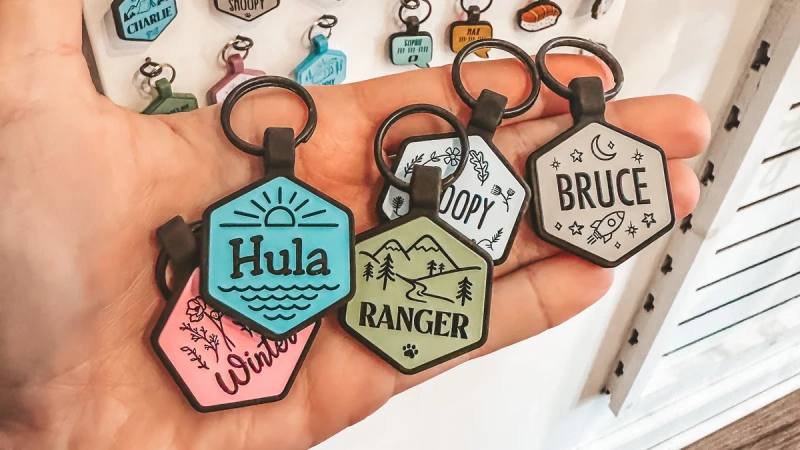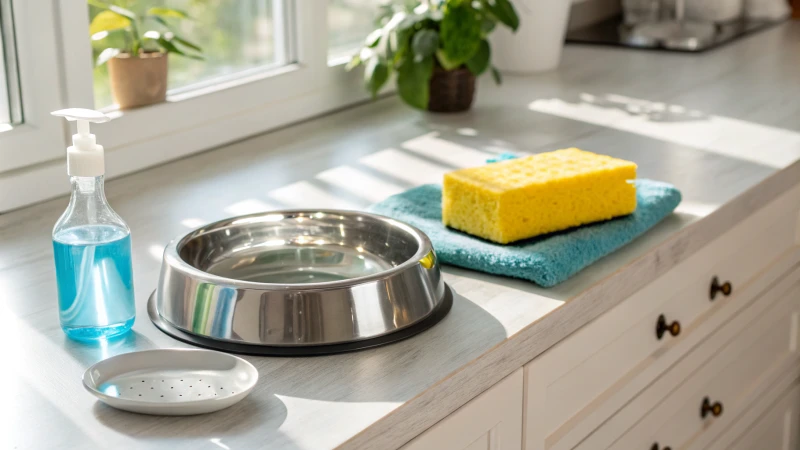
Is your dog’s bowl very clean? I want to share my journey to good pet cleanliness!
To keep things very hygienic, clean your dog’s bowls every day. Give them a really deep wash once a week. This habit stops bad bacteria from growing. Clean food and water are crucial for your dog’s health.
When I got my puppy, I felt overwhelmed with all the tasks of being a pet owner. One thing I learned was the importance of clean bowls. Daily washing of my dog’s food and water bowls really improved their health and happiness. Cleaning became a part of my routine, like morning walks. Each week, I spend a bit more time for a deep clean. Trust me, it’s very worth it!
Dog bowls should be washed daily for hygiene.True
Daily washing of dog bowls prevents harmful bacteria buildup and promotes pet health.
Thorough cleaning of dog bowls is unnecessary weekly.False
Weekly thorough cleaning is essential to maintain hygiene and ensure pet safety.
What Are the Risks of Not Cleaning Dog Bowls Regularly?
Think about what may hide in your dog’s food and water bowls. Many people ignore this, but dirty bowls could cause serious health problems. This does not only affect pets; it can also cause trouble for people.
Not cleaning dog bowls frequently allows bacteria to grow. This bacterial spread can harm dogs’ stomachs. People might also face health issues through cross-contamination. Owners must wash dog bowls every day. This habit keeps your pet safe. A clean bowl creates a healthy space for your dog. Very important.

Bacterial Growth
Not cleaning dog bowls often can lead to harmful bacteria like Salmonella and E. coli. These little invaders love moist places, especially when food bits are left behind. I remember the time I accidentally left my dog’s bowl unwashed for a few days. The smell was awful. I realized I was risking both his health and mine.
Effects on Health
- For Dogs: Eating bacteria can cause stomach problems, like vomiting and diarrhea. Nobody wants their dog to suffer from an upset stomach!
- For Humans: Touching dirty bowls can cause health problems, especially if hygiene is not followed. It’s not worth the risk!
Understanding these risks helps pet owners maintain hygiene. Learn more about pet health1.
Signs of Contamination
Dirty dog bowls may show signs of harmful bacteria:
| Signs | Description |
|---|---|
| Foul Odor | A strong, unpleasant smell from the bowl. |
| Residue Build-up | Visible food particles or slime on the bowl. |
| Discoloration | Stains or discoloration on the surface. |
Regular checks of these signs help keep your pet’s feeding area safe and clean. Check out cleaning tips2.
Importance of Regular Cleaning
Keeping dog bowls clean is very important.
- Preventing Infections: Washing often really reduces the risk of infections in pets due to bacteria in dirty bowls. I started washing my dog’s bowls daily after realizing how much it could harm his health.
- Maintaining Hydration: Fresh, clean water in bowls is crucial for your dog’s hydration and overall health. Dirty water probably leads to urinary tract infections and other issues. I’ve learned that nothing beats the peace of knowing my dog has clean water.
A regular cleaning schedule greatly improves your dog’s health. Discover effective cleaning routines3.
Dirty dog bowls can harbor harmful bacteria like Salmonella.True
Not cleaning dog bowls regularly allows bacteria such as Salmonella to thrive, posing health risks to both dogs and humans.
Regularly cleaning dog bowls prevents urinary tract infections in dogs.True
Maintaining clean water bowls ensures hydration and reduces the risk of urinary tract infections in dogs caused by contaminated water.
How Can I Keep My Dog’s Bowls Spotless and Healthy?
Cleaning my dog’s bowls every day has become a ritual I love. This habit shows care and affection, not just focus on hygiene. I want to share how this simple task becomes special for my furry buddy.
Clean your dog’s bowls every day with hot, soapy water. Scrub them very thoroughly once a week. Change the water daily so your pup stays very hydrated and healthy. Water is important.
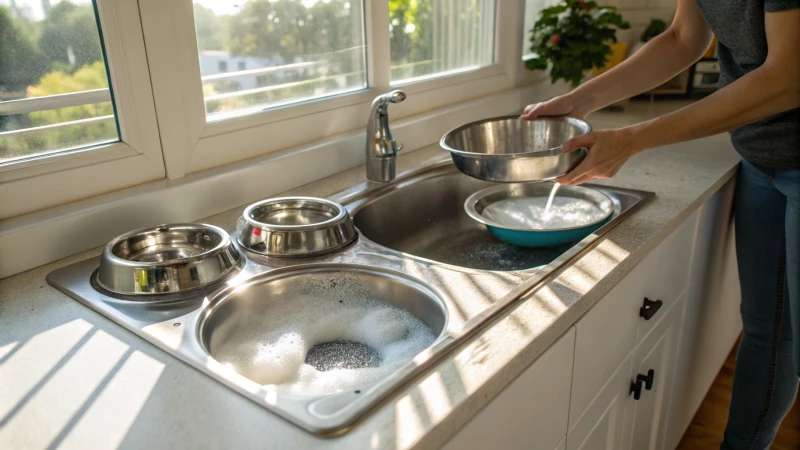
Washing Frequency
Daily Cleaning:
Each day, I wash my dog’s food and water bowls. This quick routine stops bacteria from growing. I see it as a small act of love for my pup. Thinking of her drinking from a clean bowl gives me calmness.
Thorough Cleaning:
Once a week, I do more. With soap and hot water, I scrub the bowls until they look shiny. This extra work feels good because I know I’m keeping her eating area very clean.
Importance of Regular Cleaning
Preventing Bacterial Growth:
Dog bowls might become places where harmful bacteria grow – especially if food or water sits too long. One time, I didn’t wash her bowl for a couple of days. The residue that formed was shocking. That moment taught me why regular cleaning matters for my furry friend’s safe eating environment.
Maintaining Hydration:
I change the water every day. Seeing her eagerly drink from a fresh bowl is heartwarming. It keeps her hydrated and happy. Fresh water is vital for her health. It feels good to know she’s getting the best.
| Cleaning Task | Frequency | Purpose |
|---|---|---|
| Rinse Bowls | Daily | Remove leftover food/water |
| Scrub with Soap | Weekly | Eliminate bacteria & stains |
| Change Water | Daily | Ensure fresh drinking supply |
By following these simple steps, I believe I’m helping to keep my dog healthy and happy. To learn more about keeping your pet clean, visit cleaning dog bowls effectively4.
Recommended Products for Cleaning
Using the right cleaning products has really helped:
- Pet-safe Dish Soap:
I always choose biodegradable soaps without harsh chemicals. It’s safe for my dog and kind to the planet. - Vinegar Solution:
My vinegar and water mix works as a great natural cleaner. It also leaves a fresh smell. - Baking Soda:
For bad odors or stains, I sprinkle some baking soda into the bowls before scrubbing. It’s amazing!
For more gentle solutions for pets, explore natural cleaning alternatives5.
These cleaning habits keep my dog’s bowls spotless and strengthen our bond. A happy pup deserves a clean feeding space.
Dog bowls should be cleaned daily to prevent bacteria buildup.True
Daily cleaning of dog bowls is essential to minimize bacterial growth, ensuring a safe eating environment for pets.
Changing your dog's water bowl daily is unnecessary for hydration.False
Daily water changes are crucial for maintaining hydration and providing fresh drinking water for dogs' health.
What Cleaning Products Are Safe for Pet Bowls?
Pet parents know how important it is to keep furry friends safe and healthy. Cleaning their bowls properly is very important. Which products should we use? Let’s explore some safe options together!
Always choose natural cleaners like vinegar or baking soda for washing pet bowls. These are effective and non-toxic. Use commercial products marked as pet-safe. Look for non-toxic and biodegradable options.
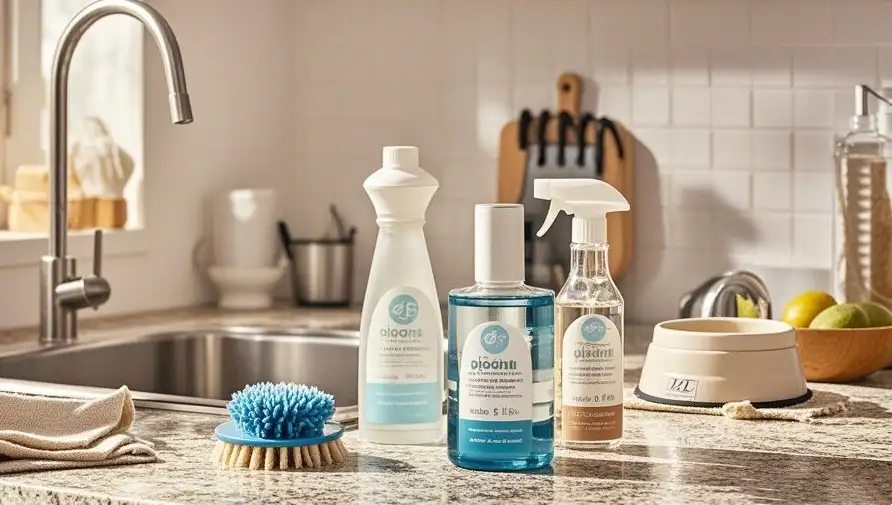
Importance of Safe Cleaning Products
When I got a pet, I was surprised by how much bacteria could hide in my dog’s food and water bowls. I hadn’t thought about it before! Since pets often lick their bowls clean, using safe cleaning products is very important for their health.
Natural Cleaners
After some research and a few problems with harsh chemicals, I started using natural cleaning solutions like vinegar and baking soda. These are my favorites now. They’re not just safe; they work really well too! Here’s a quick overview:
| Product | Use Case | Safety for Pets |
|---|---|---|
| Vinegar | Disinfecting and deodorizing | Safe |
| Baking Soda | Stain removal and odor control | Safe |
| Castile Soap | General cleaning | Safe in moderation |
Using these natural options has changed how I care for my pet’s feeding area. I feel good knowing that I keep it clean without leaving harmful residues for my furry friend.
Recommended Commercial Products
If I need something quick from the store, I always choose products labeled as pet-safe. It is comforting to see many brands creating cleaners without harmful chemicals. Here’s what I check for:
- Non-toxic ingredients: The label should say "pet-friendly" or "non-toxic."
- Biodegradable options: These help the environment and are safer for pets.
- Fragrance-free: Strong smells can bother pets, so I pick fragrance-free ones.
DIY Cleaning Solutions
Making my own cleaning solution has changed everything for me. It’s simple, safe and I know exactly what’s in it:
- Vinegar Solution: Mix equal parts of water and white vinegar. This mix cleans and removes odors very well.
- Baking Soda Paste: Mix baking soda with a little water to create a paste. It cleans tough stains without harming my pet.
- Castile Soap Mixture: Mix Castile soap with water for a gentle cleaner, great for pet bowls.
These ways not only keep my pets safe but also support an eco-friendly cleaning routine that makes me proud.
Best Practices for Pet Bowl Hygiene
Besides cleaning products, I learned regular care is key for hygienic pet bowls:
- Daily Washing: Rinse bowls daily with warm water to stop bacteria.
- Weekly Deep Clean: Every week, scrub thoroughly with a safe cleaner – it’s part of my routine now.
- Avoid Cross-contamination: Keep pet bowls away from human dishware during washing to prevent mix-ups.
For further insights on maintaining your pet’s feeding area, check out this article on pet hygiene best practices6.
These cleaning habits ensure my pets have a safe eating environment, lowering their risk of health issues from poor bowl hygiene.
Vinegar is safe for disinfecting pet bowls.True
Vinegar effectively disinfects and deodorizes pet bowls without harmful chemicals, making it a safe choice for pet owners.
All commercial cleaning products are safe for pets.False
Not all commercial cleaners are pet-safe; always check labels for non-toxic and pet-friendly claims before use.
How Do Different Types of Bowls Impact Cleaning Frequency?
Do you ever think about whether the kind of bowl for your pet changes how often it needs washing? I have thought about this too and it is really important for your pet’s cleanliness. Let’s explore the details together!
Plastic, stainless steel or ceramic bowls need cleaning at different times. Plastic bowls need washing every day. Scratches in plastic hold bacteria. Daily cleaning is necessary. Stainless steel bowls are easy to keep clean, but washing is necessary every day. Ceramic bowls look nice. Regularly check ceramic bowls for chips. Chipped bowls are unsafe.
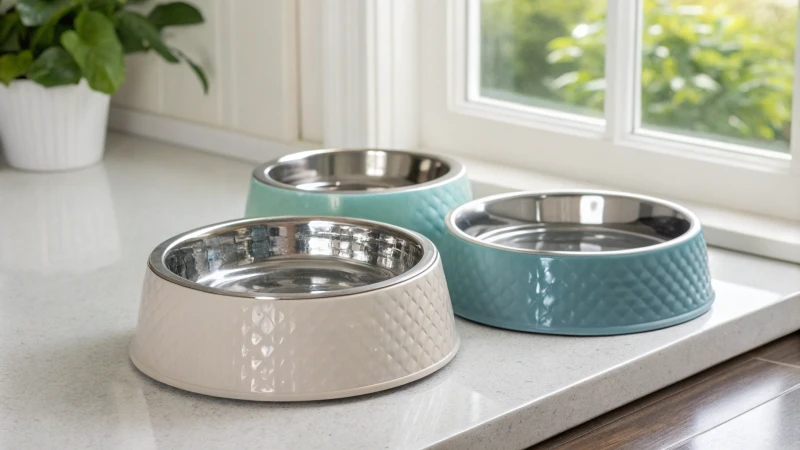
The Impact of Bowl Material on Cleaning Frequency
Different materials used for pet bowls can significantly influence how often they need to be cleaned. Here’s a breakdown of popular bowl materials:
| Bowl Material | Cleaning Frequency | Pros | Cons |
|---|---|---|---|
| Plastic | Daily | Lightweight, affordable | Can scratch easily, may harbor bacteria over time |
| Stainless Steel | Daily | Durable, easy to clean | Can be noisy, may get hot in the sun |
| Ceramic | Daily | Aesthetic, heavy and stable | Can chip easily, requires careful handling |
Plastic Bowls: These were my first choice because they are cheap and easy to get. But, scratches appear over time, trapping bacteria. Strange smells began after a few weeks. Now, I wash plastic bowls every day and look for scratches.
Stainless Steel Bowls: I love these bowls! They last long and are easy to wash. Bacteria doesn’t stay easily on them like on plastic. Just to be safe, I scrub them every day. They are noisy when my dog eats, waking me up in the morning!
Ceramic Bowls: These bowls look the nicest in my kitchen. They make the pet area beautiful. But they might chip if I’m not careful. I remind myself to wash them gently. I clean them daily and give them a deep clean once a week.
Best Practices for Maintaining Pet Bowls
Here are some good habits for clean pet bowls:
- Daily Rinse: After meals, I rinse the bowls to clear food bits. This is now a habit.
- Weekly Deep Clean: Every week, I scrub with hot soapy water for a thorough clean.
- Avoid Soaking: Soaking doesn’t work for me. It invites bacteria if I don’t rinse them right.
Using the right cleaning items helps a lot:
- Non-toxic soap: I check that it’s safe for my pets.
- Bacterial sprays: Sometimes, I use pet-safe sprays for extra safety.
For detailed cleaning tips, read this article7. By sticking to these cleaning habits, I keep my pets happy and healthy, away from infections from dirty bowls.
Plastic bowls require daily cleaning due to bacteria risk.True
Plastic bowls can develop scratches that harbor bacteria, necessitating daily cleaning for pet safety.
Ceramic bowls do not need daily cleaning.False
Ceramic bowls should be cleaned daily to prevent bacterial growth from chips and cracks.
Conclusion
Daily cleaning of dog bowls prevents bacteria buildup, ensuring pet health. A weekly deep clean further protects against contamination, promoting hydration and overall well-being.
-
This link provides essential tips for keeping pet feeding areas hygienic and safe, ensuring the health of your furry friend. ↩
-
Learn how to spot signs of contamination in dog bowls and what to do about it for your pet’s safety. ↩
-
Find out effective cleaning routines that will help keep your dog’s feeding areas clean and healthy. ↩
-
Discover effective methods and tips for keeping your dog’s bowls clean and hygienic. ↩
-
Learn about natural cleaning solutions that are safe for pets. ↩
-
Explore effective and safe cleaning solutions specifically designed for pet owners to ensure the health of your furry friends. ↩
-
Explore detailed strategies to keep your pet bowls hygienic and safe for daily use. ↩


